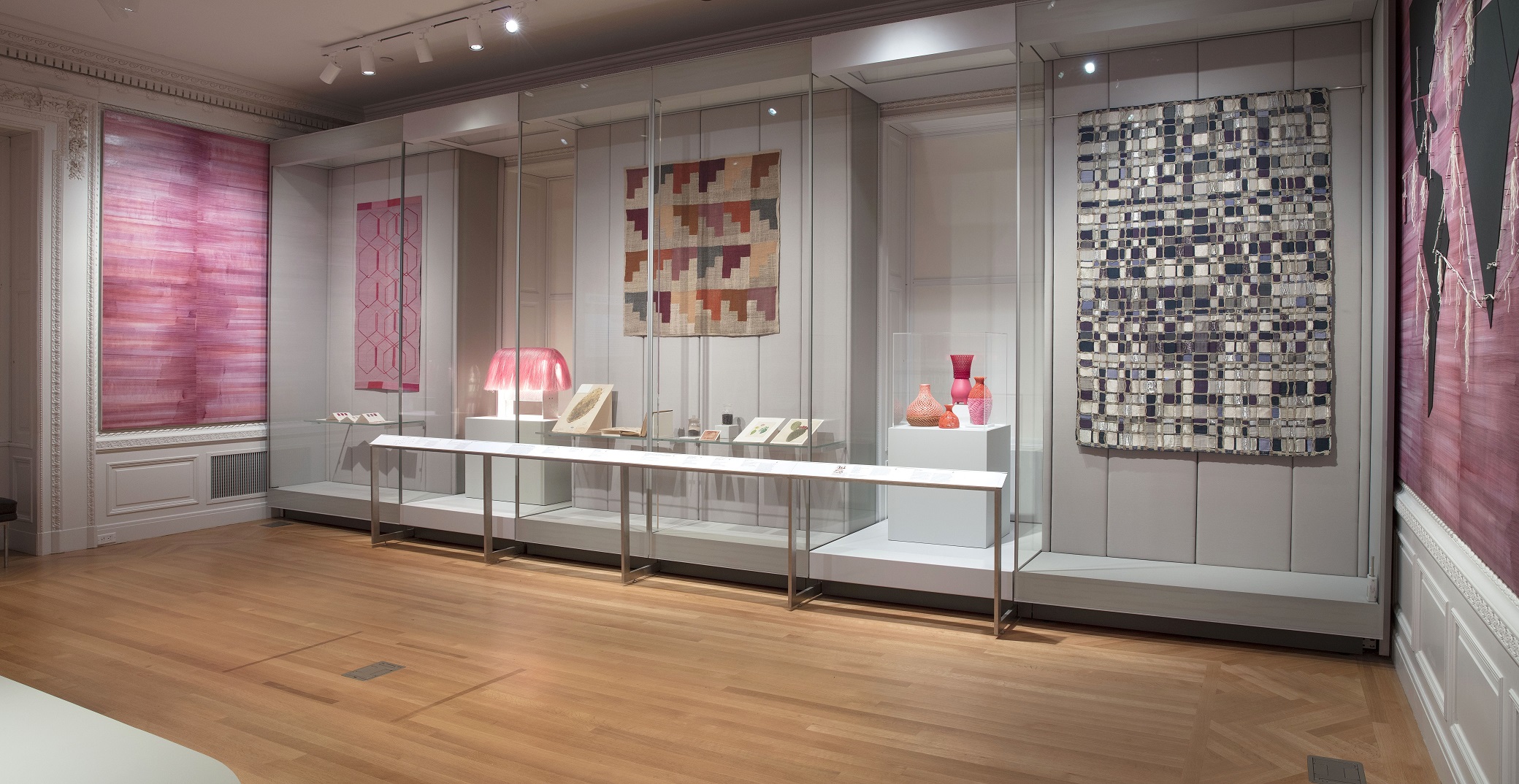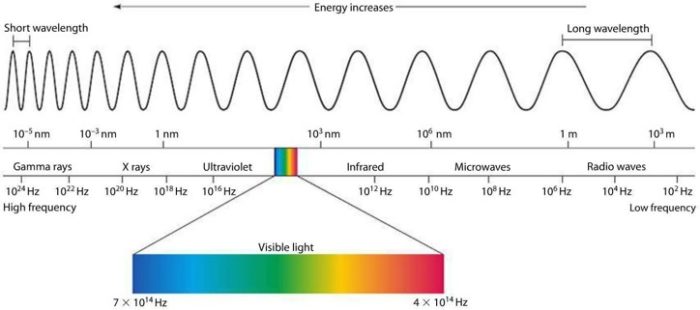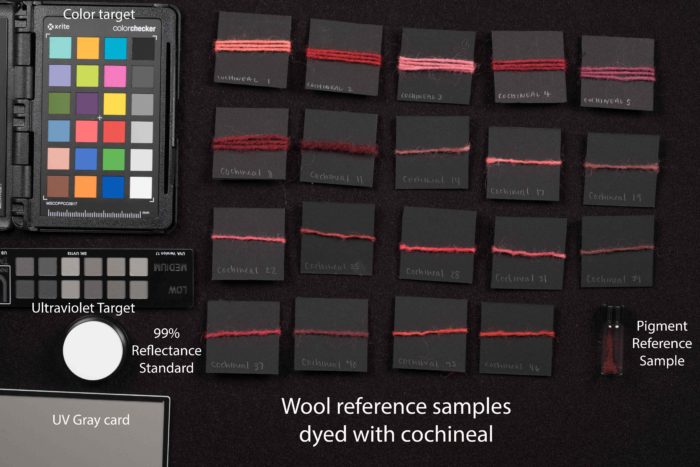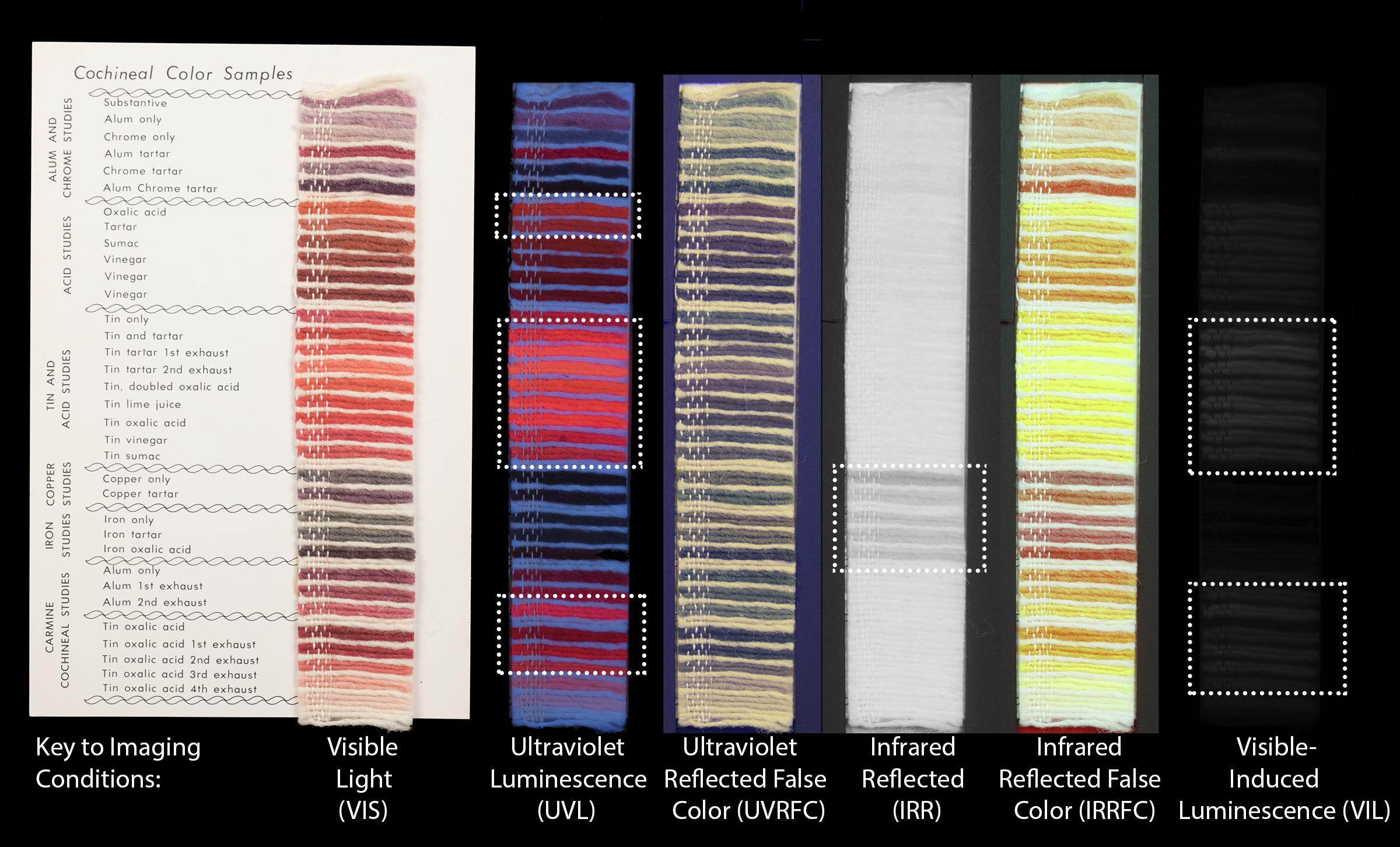
Installation view of Nature by Design: Cochineal. Photo: Matt Flynn © Smithsonian Institution
by Jessica Walthew (objects conservator), Kira Eng-Wilmot (textile conservator), and Pauline Nguyen (conservation intern)
Cooper Hewitt’s Conservation team recently acquired a Multiband imaging (MBI) photography kit, a useful tool for investigating pigments, coatings, and other artistic materials. In preparation for the exhibition Nature by Design: Cochineal, we worked with our summer intern Pauline Nguyen to investigate what we could learn about dyes using this new imaging tool. This is the first of a series of posts about this ongoing research focusing on cochineal-dyed textiles.
Cochineal, one of the most important historic dyestuffs, is a brilliant red dye produced by grinding the dried bodies of the insect, Dactylopius coccus, which feeds on the prickly pear cactus. Imbued with profound artistic, cultural, and economic significance for indigenous peoples of Mexico and the Andean highlands of South America, cochineal was transformed into a widely traded global commodity upon European contact in the 16th century and became a coveted textile dye for the next 300 years. Contemporary designers inspired by cochineal and working in a variety of media, from wallcoverings to 3D-printed objects, are featured in Cooper Hewitt’s Cochineal exhibition (on view through May 2020).
We were particularly interested to learn more about two of the textiles in our collection through imaging. Imaging textiles can be especially difficult as the dye formulation, the fiber type, and combinations of dyes must be considered. The color of a dye depends on complex chemical interactions between the dyestuff, as well as mordants and pH of the dyebath. Color can also be affected by pre- or post-treatments of the fiber and by aging over time.
The basics: Multiband imaging captures information that the unaided human eye cannot detect—in regions of the electromagnetic spectrum beyond visible light (400–700 nm). Similar to how night-vision cameras use infrared rather than visible light to extend our ability to process images, special camera equipment is used to capture images in the ultraviolet and infrared portions of the electromagnetic spectrum.

Electromagnetic spectrum, image credit: Wikimedia.
Our equipment involves a modified digital camera, several light sources, and lens filters. We use three types of radiation sources: visible, ultraviolet (200 to 400 nm), and infrared (700 to 900 nm). Using various lens filters, images are taken in order to record how the object responds in different illumination conditions. Reference targets in the images help create consistent exposures so that comparisons can be made between different objects. Further manipulation during photo editing to combine the photos helps us visualize differences between these images.

A visible light image of dyed wool fibers, with annotations to describe the reference targets used for image calibration.
Researchers at the British Museum, The Metropolitan Museum of Art, Smithsonian Museum Conservation Institute, and Brooklyn Museum have helped develop protocols that are now becoming more widely used by the conservation field (see references below). Previous studies have revealed the complex relationships between dyes and fibers (1). In our study, we investigated the response of cochineal-dyed wool fibers with different types of mordants using a sheet of reference samples showing many different shades achieved with the same dye. Then we used this information to see if we could draw any conclusions about objects that were identified as also containing cochineal as a colorant–we’ll detail these observations in subsequent posts.

The same reference samples captured with different combinations of light source and filters. L to R: Visible light, Ultraviolet Luminescence (UVL), Ultraviolet Reflected False Color (UVRFC), Infrared Reflected (IRR), Infrared Reflected False Color (IRRFC), and Visible Induced Luminescence (VIL)
Our preliminary findings helped build our understanding of how these complex interactions between fibers and dyes can be visualized with Multiband imaging. They also underscore the value of understanding the geographic, cultural, and historical context of an object in interpreting the images. Some interesting observations highlighted in the image above include: only some of the mordants (e.g. tin, tartar) showed strong fluorescence in the ultraviolet luminescence (UVL) image. We observed a weak response in visible-induced luminescence (VIL) for the tin/tartar samples as well. Only a few samples dyed with iron or copper mordants showed any response in the infrared reflected image (IRR). We will use these results to help interpret images of collections objects, and to help guide further analysis.
Notes: (1) Webb, Summerour, and Giacci used MBI and another technique called hyperspectral imaging to investigate materials used in Andean archaeological painted textiles and found that manipulating the photos using an image subtraction technique (described in detail in our next blog post!) was quite useful in characterizing indigo pigments in these objects with limited color palettes. Dyer, Tamburini, O’Connell, and Harrison used a full suite of multispectral imaging techniques along with other complementary non-invasive and micro-invasive techniques to investigate the dyes used in Late Antique textiles from Egypt, creating a comprehensive workflow for this type of imaging.
Acknowledgements: Cooper Hewitt’s imaging suite was purchased with funds granted from the Smithsonian Research Equipment Pool. Our special thanks to Dawn Kriss and Anna Serotta for training and advice, and Pauline Nguyen for her work carrying out the imaging during her 2019 Krueger summer internship in conservation.
References:
Dyer, Joanne, Giovanni Verri, and John Cupitt. (2013) Multispectral Imaging in Reflectance and Photo-induced Luminescence modes: A User Manual. European CHARISMA Project.
Dyer J, Tamburini D, O’Connell ER,Harrison A. (2018) A multispectral imaging approach integrated into the study of Late Antique textiles from Egypt. PLoS ONE 13(10): e0204699. https://doi.org/10.1371/journal.pone.0204699
Dyer, J. and Sophia Sotiropoulou. (2017) A technical step forward in the integration of visible-induced luminescence imaging methods for the study of ancient polychromy. Heritage Science 2017(5(1)):24 DOI: 10.1186/s40494-017-0137-2 https://heritagesciencejournal.springeropen.com/articles/10.1186/s40494-017-0137-2
Kriss, Dawn, Anna Serotta, Giacomo Chiari, Caroline Roberts and Marie Svoboda. (2016) “Visible-Induced Luminescence Imaging: Past, Current and Future Applications in Conservation Research” American Institute for Conservation 44th Annual Meeting, May 16, 2016. https://aics44thannualmeeting2016.sched.com/event/4hfy/research-and-technical-studies-visible-induced-luminescence-imaging-past-current-and-future-applications-in-conservation-research. See also https://www.conservators-converse.org/2016/05/44th-annual-meeting-may-16-research-and-technical-studies-visible-induced-luminescence-imaging-past-current-and-future-applications-in-conservation-research-dawn-kriss-and-anna-serotta/
Kriss, Dawn, and Anna Serotta, blog post on Multispectral Imaging at the Brooklyn Museum of Art. https://brooklynmuseum.tumblr.com/post/143940383700/as-youve-seen-in-several-of-our-recent-posts-on
Suh, Kisook. (2018) “Application of Multispectral/Multiband imaging in the practice of textile conservation: documentation, investigation, and communication.” AIC Textile Specialty Group Postprints Volume 28: 83-96.
Verri, Giovanni. (2009) “The spatially resolved characterisation of Egyptian blue, Han blue and Han purple by photo-induced luminescence digital imaging”, Anal Bioanal Chem., 2009 394(4) 1011-21
Verri, Giovanni, and Janet Ambers. (2010) Digital Mapping of Egyptian Blue: Conservation Implications. Studies in Conservation. (add addl citation)
Webb, E. Keats, and Rebecca Summerour. “Peruvian Textiles Analysis: MCI Imaging Studio | Museum Conservation Institute | Smithsonian.” Accessed December 12, 2016. http://www.si.edu/MCIImagingStudio/PeruvianTextiles.
Webb, E. Keats, Rebecca Summerour, and Jennifer Giacci. (2014) “A Case Study using Multiband and Hyperspectral Imaging for the Identification and Characterization of Materials on Archaeological Andean Painted Textiles.” AIC Textile Specialty Group Postprints Volume 24: 23-35.